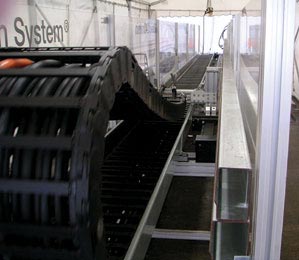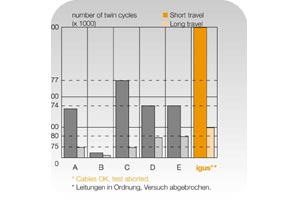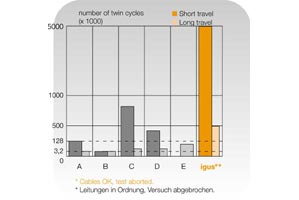chainflex® - Cables for Cranes
More than 950 igus® special cable types ex stock
tested, tested, tested and testedAs a producer of energy chains® and special energy chain® cables, igus® has the facilities to examine chains and cables in practical use. In its own test labs in Cologne, many extremely demanding applications are tested in parallel. Currently over 35 tests are running with actual equipment. The results are collected into a comprehensive data pool which forms a very precise instrument for judging the lifetime of the equipment in particular situations. And the data pool is also used within the company as a basis for new designs. The precise data regarding cables, chains and also the customized e-chainsystems® enables igus® to give a system guarantee (depends on application).
Special cables for the Cranes industry
Shielded highly flexible single core for up to 6/10kV Medium voltage cable for the most demanding requirements in Crane building, heavy machinery, etc. Cross sections: 1 x 25/16 to 1 x 95/16.
chainflex® bus cables are available for all continuous bus systems for the e-chain® application. Also in heavy-duty cross sections, for example 3 x 2 x 2.5mm² or with voltage
supply cores in a cable.
Shielded servo cable for converter operation up to 600/1000 V, with one or two shielded signal pairs. Shielded and unshielded motor cables of 1.5 to 95 mm².
Plastic (980/1000) or fiber glass (62.5/125 or 50/125), 1, 2, 6 or 12 fibers – all fiber optic cables are tested for over several million flexing cycles.
Plastic (980/1000) or fiber glass (62.5/125 or 50/125), 1, 2, 6 or 12 fibers – all fiber optic cables are tested for over several million flexing cycles.
Shielded and unshielded single core motor cables for the most demanding requirements.
PVC, PUR, TPE – a wide range to select from all application areas – between shielded and unshielded cables and a large number of cross sections and number of cores.

Test of energy chains® and chainflex® at the igus® Testlab
7 basic rules for a good cable
1. Strain-relieving center
Clear space is created in the center of a cable according to the number of cores and the cross section of each cable. This center should be filled, as far as possible, with a genuine center cord (and not, as frequently the case, with fillers or dummy cores consisting of waste materials). These measures will then efficiently protect the stranded structure situated above and prevent the stranding from wandering into the middle of the cable.
With respect to the selection of litz wires, the maximum flexibility has proved to be the best solution. Although very flexible conductors can be made using very thin individual wires, these conductors tend toward extreme formation of kinks. Long-term series of tests provided the result of a shielded combination of single-wire diameter, pitch length and pitch direction as the best bending-resistant solution.
The insulation materials must be made so that they do not stick to one another within the cable. Furthermore, the insulation is also required to support the stranded individual wires of the conductor. Accordingly, only the highest-quality, high-pressure-extruded PVC or TPE materials that have proved their tested reliability in millions of core kilometers are then used in energy Cchain® applications.
The stranded structure must be stranded around a stable, tension-proof center with an optimized short pitch length. However, due to the insulating materials being used, this stranded structure should still be defined in mobile form within the stranding. Starting from a quantity of 12 cores, however, the method of stranding in bundles should be applied.
A gusset-filling extruded inner jacket must be used instead of inexpensive fleeces, fillers or accessory fillers. This measure ensures that the stranded structure is efficiently guided in longitudinal direction. Moreover, the stranded structure cannot fall apartor wander off.
The total shield should be made tight using an optimized shield braiding angle over an extruded inner jacket. Loose open braids or wrapped stranding reduce the EMC protection considerably and can fail very quickly due to shield wire breakage. A tight total braid shield also has a torsion protection effect on the stranded structure.
The material-optimized outer jacket can fulfil many different requirements: From UV-resistant to low-temperature-flexible, and from oil-proof to cost-optimized. But these outer jackets must have one thing in common: A jacket material must be highly abrasion-resistant but not be allowed to stick to anything. It must be flexible but also provide a supporting function. In any case, the jacket should also be extruded under pressure (gusset-filling).
Your contact
Theo Diehl +49 6162 6808 Your requirements?
More than 100,000 products available! Delivery and consultation Mon-Fri from 7am-8pm and Sat from 8am-12pm!







